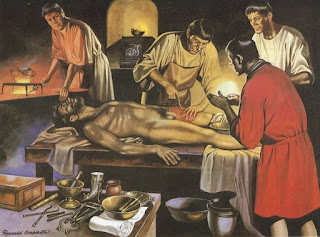 ANTINOUS is the God of the Men with the Pink Triangles, gay victims of the Nazis.
ANTINOUS is the God of the Men with the Pink Triangles, gay victims of the Nazis. So it is with profound humility that we proclaim an anti-Nazi resistance fighter and the last known gay Jewish survivor of the Holocaust to be a Saint of Antinous.
GAD BECK died in Berlin in 2012 six days before his 89th birthday on June 30.
Beck was a pioneering gay activist and educator in a severely anti-homosexual, repressive post-World War II German society. He was famous for his witty, lively style of speaking.
On a German talk show, he said with a wink to his small physical size, "The Americans in New York called me a big hero. I said no... I’m really a little hero."
Perhaps the single most important experience that shaped his life was the war-time effort to rescue his boyfriend. Beck donned a Hitler Youth uniform and entered a deportation center to free his Jewish lover Manfred Lewin.
After bluffing his way out of the deportation center, as the two youths were hurrying down the road to freedom, Manfred stopped and said he couldn't go on.
He tearfully said he would never forgive himself if he abandoned his family. So, with a parting kiss, he turned back and Gad never saw him again.
The Nazis would later deport the entire Lewin family to Auschwitz, where they were murdered.
Gad's only memento of Manfred was a little notebook with poems, sketches and essays which Manfred had written, plus a photograph. Gad treasured them all his life.
Speaking about his life as a gay Jew, Beck invoked a line frequently cited about homosexuality: "God doesn't punish for a life of love."
He was featured in the film THE LIFE OF GAD BECK (Die Freiheit des Erzählens: Das Leben des Gad Beck) as well as in the German documentary film PARAGRAPH 175. (The notorious Paragraph 175 of the German Penal Code outlawed homosexuality before Adolf Hitler became chancellor in 1933, and the Nazi party radically intensified the enforcement of the anti-gay law, including deportations to extermination camps.)
Aside from the two documentaries, however, he said with typical humor that he was still waiting for the blockbuster, feature-length movie about his life, and he knew just the man to bring it to the big screen.
"Only Steven Spielberg could film my life – forgive me, forgive me," Beck quipped.
He had immigrated to Israel in 1947. After his return to Germany in 1979, the first post-Holocaust head of Berlin's Jewish community, Heinz Galinski, appointed Beck director of the Jewish Adult Education Center in Berlin.
In a telephone interview with Judith Kessler, editor of the Berlin Jewish community's monthly magazine, Juedisches Berlin, she told THE JERUSALEM POST that Beck would organize gay singles meeting in the center.
"He was open, sweet and would speak with everybody," she said. Kessler, who knew Beck since 1989, added that he would attend the annual Christopher Street Day Parade for gay pride in Berlin and wave an Israeli flag.
Beck's father was an Austrian Jew and his mother converted to Judaism.
The Nazi racial laws defined Beck as mischling (mixed-breed), and he and his father were carted off to a holding compound in the Rosenstrasse in central Berlin.
After the non-Jewish wives of the prisoners launched a massive street protest in 1943, Beck was released. There were "thousands of women who stood for days... my aunts demanded 'give us our children and men'," he said.
The Rosenstrasse demonstration helped debunk the widespread myth in post-Holocaust German society that resistance against Nazism was futile.
"The Rosenstrasse event made one thing absolutely clear to me: I won't wait until we get deported," said Beck.
Following his release, Beck joined Chug Chaluzi, an underground Zionist resistance youth group, and played a key role in securing the survival of Jews in Berlin.
According to the entry about him at the Holocaust Memorial Museum in Washington, he noted that "as a homosexual, I was able to turn to my trusted non-Jewish, homosexual acquaintances to help supply food and hiding places."
Shortly before the end of the war in 1945, a Jewish spy working for the Gestapo betrayed Beck and some of his fellow resistance fighters.
He was held captive at a Jewish transit camp in Berlin. After the defeat of Nazi Germany, Beck continued his Zionist work and helped Jewish survivors emigrate to Palestine. He remained in Israel between 1947 and 1979.





































